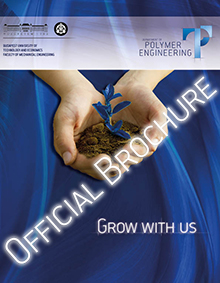Upcycling of crumb rubber after microwave devulcanization in rubber and thermoplastic elastomer formulations
Dr. László Mészáros
Dr. Bálint Morlin
Dr. Péter Tamás-Bényei
Dániel Ábel Simon
Dávid Zoltán Pirityi
Project summary
The economic recycling of used rubber products (tyres, conveyer-belt, production scrap) is a great challenge nowadays. Material recycling is the preferred way supported by legislative actions and economical/ecological arguments. Incorporation of crumb rubber (CR) in vulcanizable rubbers and thermoplastic resins is accompanied with prominent degradation in the mechanical properties. The extent of latter in a given rubber or thermoplastic system depends on the CR particle size and on its incorporated amount. Economical use of CR fractions requires that instead of using costly polymeric compatibilizers the surface of CR particles should be “activated”. This covers also the creation of dangled molecular chains which may entangle with those of the matrix thereby producing a strong interphase which guarantees improved mechanical performance. Our research strategy is to break up the sulphur crosslinked network and thus generate “active” molecules by microwave devulcanization of the CR before adding it in selected rubbers and thermoplastics. Accordingly, the project is devoted to the recycling and “upcycling” of microwave decomposed CR in rubber and thermoplastic resin-based recipes, respectively. Upcycling means the production of a value-added product, namely CR-containing thermoplastic rubbers. Major targets are: i) to enhance the amount of CR that can be added in fresh rubber without property penalty, and ii) to develop CR-containing thermoplastic rubbers which may compete with present commercial types based on their favorable property/cost balance.
Project results
Project-related publications
- Kiss L., Simon D. Á., Petrény R., Kocsis D., Bárány T., Mészáros L.: Ground tire rubber filled low-density polyethylene: The effect of particle size. Advanced Industrial and Engineering Polymer Research, 5, 12-17 (2022) 10.1016/j.aiepr.2021.07.001
- Simon D. Á., Bárány T.: Effective thermomechanical devulcanization of ground tire rubber with a co-rotating twin-screw extruder. Polymer Degradation and Stability, 190, 109626/1-109626/12 (2021) 10.1016/j.polymdegradstab.2021.109626 IF=5.204 Q1
- Halász I. Z. , Kocsis D. , Simon D. Á. , Kohári A. , Bárány T. : Development of Polypropylene-based Thermoplastic Elastomers with Crumb Rubber by Dynamic Vulcanization: A Potential Route for Rubber Recycling. Periodica Polytechnica-Chemical Engineering, 64, 248-254 (2020) 10.3311/PPch.13962 IF=1.571 Q3
- Pirityi D. Z., Pölöskei K., Bárány T.: Etilén-propilén-dién-monomer gumi termomechanikai devulkanizációja hengerszéken. Polimerek, 6, 797-801 (2020)
- Simon D. Á., Pirityi D. Z., Bárány T.: Devulcanization of ground tire rubber: microwave and thermomechanical approaches. Scientific Reports, 10, 16587/1-16587/13 (2020) 10.1038/s41598-020-73543-w IF=4.379 Q1
- Simon D. Á., Pirityi D., Tamás-Bényei P., Bárány T.: Microwave devulcanization of ground tire rubber and applicability in SBR compounds. Journal of Applied Polymer Science, 137, 48351/1-48351/8 (2020) 10.1002/app.48351 IF=3.125 Q2
- Simon D. Á., Halász I. Z., Karger-Kocsis J., Bárány T.: Microwave Devulcanized Crumb Rubbers in Polypropylene Based Thermoplastic Dynamic Vulcanizates. Polymers, 10, 767/1-767/14 (2018) 10.3390/polym10070767 IF=3.164 Q1
- Simon D. Á, Tamás-Bényei P., Bárány T.: Gumihulladék mikrohullámú devulkanizációja. Zöld Ipar Magazin, 7, 17-19 (2017)
- Kocsis D., Bárány T.: Polipropilén alapú termoplasztikus dinamikus vulkanizátumok fejlesztése. Polimerek, 2, 301-304 (2016)






